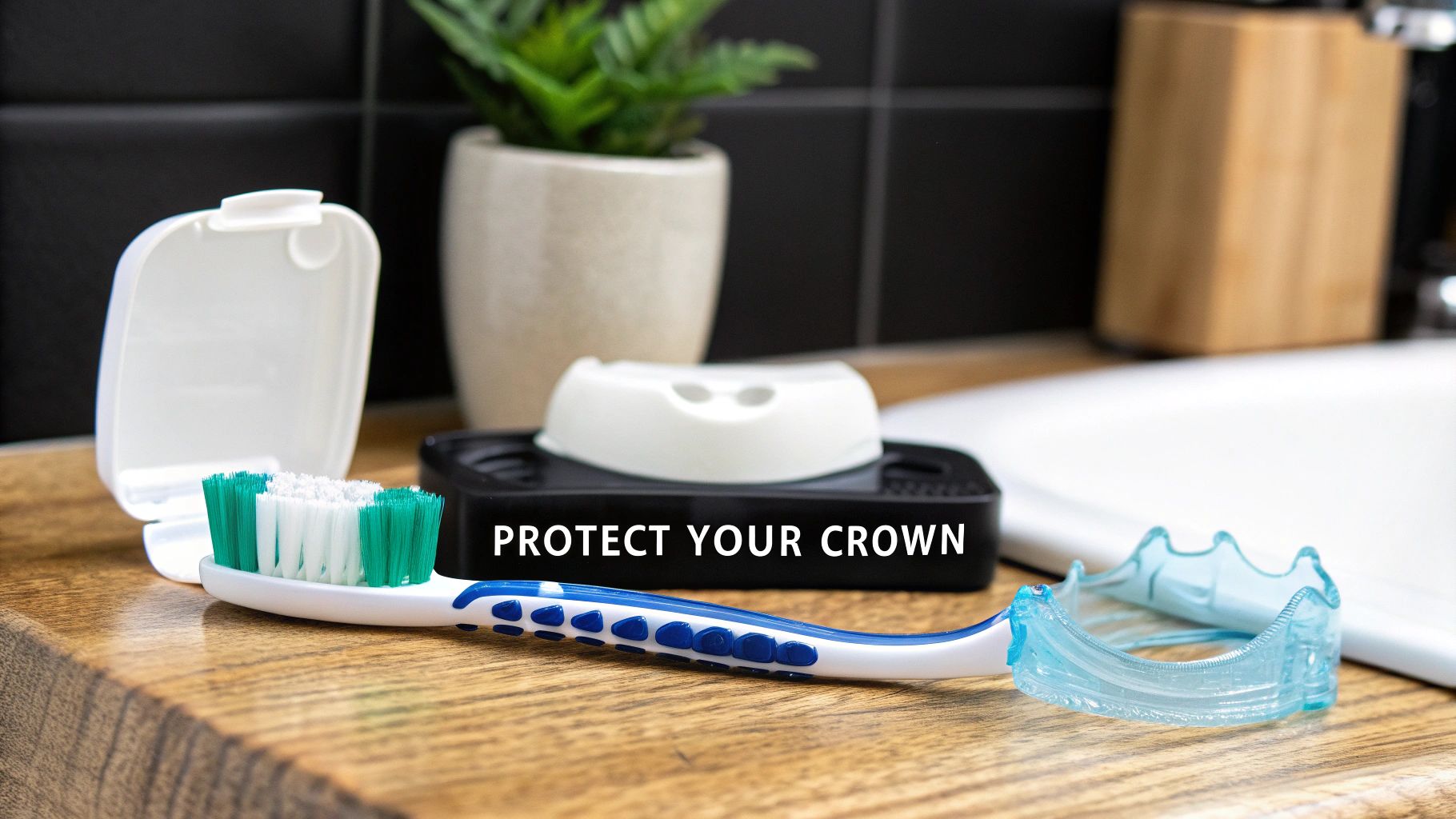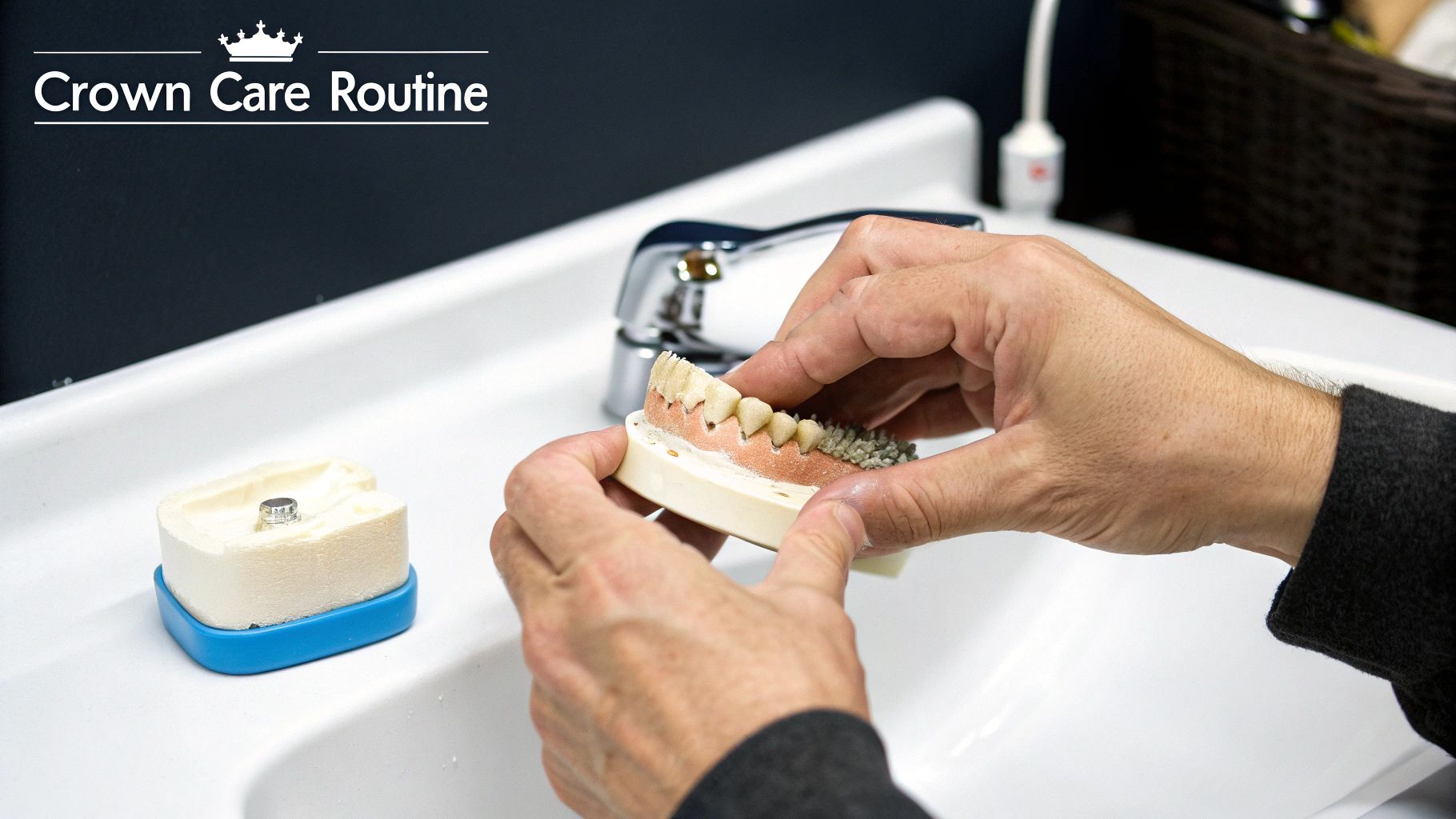How Long Do Dental Crowns Last? An Actionable Guide to a Longer Lifespan
- Caterina Rutter
- Oct 22
- 11 min read
Wondering how long your dental crown will actually last? The standard answer is 5 to 15 years, but that’s just an average. The real lifespan of your crown depends less on a warranty and more on your actions.
Think of it this way: the longevity of your crown isn't a passive waiting game. It’s an outcome you directly influence through the choices you make every day. The materials, your habits, and your dentist's skill all play a part, but you are in the driver's seat.
What Really Determines Your Crown's Lifespan?
While the 5-to-15-year window is a common estimate, many crowns last for decades with the right care. Conversely, a crown can fail in under five years if neglected. Your crown's durability is a direct result of its material, your dentist's expertise, and your daily habits.
Here are the three factors you need to manage:
The Crown's Material: This is the foundation. A robust gold crown is built to withstand intense chewing forces, while an all-porcelain crown, chosen for its aesthetics, might be more vulnerable to chipping if you grind your teeth. Each material has specific care requirements.
Your Personal Habits: Do you grind your teeth at night? Chew on ice? Use your teeth to open packages? These actions place extreme stress on your crown—far beyond normal eating—and can significantly shorten its life. Identifying and stopping these habits is a critical step.
Your Oral Hygiene Routine: This is where you have the most control. To make your crown last, you must keep the area where it meets your gum line meticulously clean. If plaque accumulates there, decay can form on the underlying tooth, causing the entire restoration to fail.
Real-world data shows just how much proactive care matters. A major study found that after 10 years, an impressive 80.9% of crowns were still functioning perfectly.
However, that number dropped to just over 61% by the 20-year mark, highlighting the importance of consistent, long-term maintenance. The study identified the most common reasons for failure: the crown becoming loose, the material fracturing, or the underlying tooth failing. You can review the complete long-term dental crown findings here.
To help you make an informed decision with your dentist, here is a practical look at what to expect from different crown materials.
Dental Crown Lifespan at a Glance
Crown Material | Average Lifespan (Years) | Actionable Insight |
|---|---|---|
Gold & Metal Alloys | 20-40+ | Best for back teeth; choose if you are a heavy grinder and prioritize durability over appearance. |
Porcelain-Fused-to-Metal (PFM) | 10-20 | A solid balance of strength and looks; be aware a dark line may appear at the gum line over time. |
All-Porcelain/All-Ceramic | 10-15 | Ideal for visible front teeth; requires careful habits to avoid chipping. |
Zirconia | 15-20+ | A versatile, high-strength choice for any tooth; offers durability without sacrificing aesthetics. |
Resin/Composite | 5-7 | Typically used as a temporary fix; not recommended as a permanent solution. |
Remember, these are averages. Your actions can help a porcelain crown outlast a neglected gold one.
Choosing the Right Crown Material for Durability
When we discuss how long do dental crowns last, the material is your starting point. You wouldn't use racing tires for off-roading; similarly, your crown material should match its function in your mouth.
Each option presents a different balance of strength, appearance, and longevity. Understanding these trade-offs empowers you to collaborate with your dentist for the best outcome.
Gold and Metal Alloys: The Time-Tested Tanks
For maximum durability, gold or other high-noble metal alloys are unmatched. They are incredibly tough and wear down at a rate similar to natural tooth enamel, which means they won't damage the opposing tooth.
Because of their resilience, they rarely chip or break. While not ideal for visible front teeth, they are a superior choice for molars that handle heavy chewing. With proper care, a gold crown can easily last 20 years or more.
Porcelain-Fused-to-Metal: A Blend of Strength and Beauty
Porcelain-fused-to-metal (PFM) crowns offer a practical compromise between the strength of metal and the look of porcelain. A durable metal base is covered with a layer of tooth-colored porcelain.
This hybrid design makes them a versatile option for most teeth. However, the porcelain can chip, exposing the dark metal beneath. Additionally, as gums recede over time, a dark line can become visible at the gum line.

This graphic illustrates that while material is foundational, your daily habits and professional care are equally critical to longevity.
All-Ceramic and Zirconia: The Modern Champions
For patients prioritizing aesthetics, all-ceramic and zirconia crowns are the top choices. Modern ceramics are so translucent and natural-looking that they are often indistinguishable from real teeth, making them perfect for your smile line.
Zirconia, a type of ceramic, is a revolutionary material in dentistry. It combines the strength of metal alloys with the aesthetic appeal of porcelain. This makes it an excellent choice for any tooth, including hard-working molars.
The durability gap between materials is closing. While metal alloys have a long history of lasting 15 years or more, newer high-strength ceramics and zirconia crowns now demonstrate similar lifespans, often in the 10 to 20 year range. In contrast, older composite resin crowns are far less durable and may need replacement in as little as three years. You can find more insights about crown material longevity here.
Use this checklist to guide your conversation with your dentist:
Gold: Choose for maximum durability on out-of-sight back molars.
PFM: A good all-around option, but be prepared for potential cosmetic changes over time.
All-Ceramic: The best choice for front teeth where appearance is the top priority.
Zirconia: The optimal blend of strength and aesthetics for any tooth in your mouth.
Habits That Make or Break Your Dental Crown

Once your dentist cements your new crown, its longevity is in your hands. Your daily habits—both conscious and unconscious—will determine whether that crown lasts for five years or for 25.
The seal where your crown meets your natural tooth is the most critical area. Your daily routine is the maintenance that protects this foundation from failing.
Oral Hygiene and Biting Forces: The Dynamic Duo
Your daily brushing and flossing routine is your primary line of defense. You are actively preventing plaque from building up at the gum line, which is where decay can start under the crown's edge and cause it to fail.
Equally important is managing the physical forces your crown endures. Unconscious habits can subject a crown to stresses it was never designed to handle.
Here are habits you must avoid to protect your crown:
Chewing on Hard Objects: Stop chewing on ice, hard candies, or popcorn kernels. These create intense pressure points that can chip or crack porcelain.
Using Your Teeth as Tools: Never use your teeth to open packages, tear tape, or hold objects. This unnatural pressure can cause significant damage.
Eating Extremely Sticky Foods: Taffy, caramels, and similar foods can grip the crown and exert a pulling force, potentially loosening it over time.
These may seem like minor issues, but the cumulative wear and tear is substantial. See our guide on other [bad habits that could harm your teeth](https://www.zdentist.com/post/bad-habits-that-could-harm-your-teeth) to learn more.
The Silent Threat of Teeth Grinding
One of the most destructive habits is one you may not be aware of: bruxism, or grinding and clenching your teeth. This often occurs during sleep and generates immense force that can wear down or fracture a crown.
If you wake up with a sore jaw, dull headaches, or notice your teeth look worn, you may be grinding at night. The most effective solution is a custom-fitted night guard from your dentist. This simple device acts as a cushion, absorbing the destructive forces while you sleep.
A major clinical review confirms the importance of patient care. It found that all-ceramic crowns had a 93.3% survival rate at five years. This number declines over time, often due to preventable problems like fractures and new decay.
This finding reinforces a key takeaway: even the highest quality dental work requires your active participation to last. Proactive care is the only way to ensure your crown serves you well for decades.
A Practical Care Plan to Make Your Crown Last

Maximizing your crown's lifespan isn't about luck; it's about a consistent care plan. Proactive maintenance is what transforms a standard 15-year lifespan into a 25-year success story. This simple daily routine protects your investment and your smile.
It’s the small, consistent actions that make the biggest difference. By following these steps, you are actively defending the seal between the crown and your tooth, preventing common problems before they start.
Nail Your Daily Hygiene Routine
The single most important area to focus on is the margin—the seam where the crown’s edge meets your tooth. This area is a magnet for plaque, which can cause decay underneath the crown and lead to failure. Perfecting your cleaning technique here is non-negotiable.
Here is your daily action plan:
Brush Twice a Day: Use a soft-bristled toothbrush and non-abrasive toothpaste. Aggressive brushing or gritty pastes can scratch the surface of porcelain, making it dull and more susceptible to staining.
Floss with Finesse: This is crucial. Gently slide the floss down, curve it into a "C" shape against the tooth, and clean just below the gum line. Then, pull the floss out from the side rather than popping it back up. This technique prevents you from catching the crown's edge and loosening it.
By focusing on the margin, you are defending the seal that keeps your crown secure. A compromised seal is the fastest way for a restoration to fail, so give this area the attention it needs.
Learn more about the best cleaning techniques in our guide on the advantages of flossing your teeth.
Eat Smart and Protect Your Investment
Your crown is strong, but not indestructible. Being mindful of what you eat can prevent a fracture and add years to its life. You don’t need to overhaul your diet, just be strategic.
Here are specific foods to manage carefully:
Hard Foods: Avoid chewing ice, hard candy, and un-popped popcorn kernels. These can create micro-fractures that worsen over time.
Sticky Foods: Caramels, taffy, and other chewy candies can pull on your crown. If the cement bond is weak, this force can dislodge it.
Tough Meats: Foods like beef jerky require significant grinding, which puts sustained stress on your crown.
Finally, if you suspect you clench or grind your teeth at night (bruxism), contact your dentist immediately. A custom night guard is a simple and effective solution. It provides a protective cushion, absorbing grinding pressure and giving your crown the ultimate defense.
Warning Signs Your Crown Needs a Check-Up
Unlike a check-engine light, a dental crown won’t give you an obvious warning. Instead, it provides subtle signals when something is wrong. Learning to recognize these clues is the key to early intervention, saving you from more complex and costly repairs down the road.
Think of these signs as your body's alert system. Acting quickly when you notice a change is the best way to protect your crown and the underlying tooth, ensuring your investment lasts.
Pay Attention to New Sensations
The first sign of a problem is often a change in sensation. If you feel a sudden jolt of sensitivity from hot or cold foods, it's a major red flag. This typically means the cement sealing the crown has washed out, creating a tiny gap that exposes the sensitive tooth structure underneath.
Pain or discomfort when you bite down is another critical signal. This pressure sensitivity could indicate that the crown’s fit is slightly off and needs a simple adjustment. However, it could also point to a more serious issue, like a crack in the tooth itself.
A loose or wobbly feeling is never normal. If your crown moves at all when you push on it with your tongue or finger, the seal has failed. This is a dental emergency because it leaves the vulnerable tooth exposed to bacteria and decay.
Addressing these sensations early can mean the difference between a simple re-cementing and needing a root canal or a new crown.
Look for Visible Changes
Make it a habit to visually inspect your crown regularly. Spotting physical signs of wear can help you address issues before they escalate. Even minor visual changes are worth discussing with your dentist.
Here is a checklist of what to look for:
Visible Chips or Cracks: Run your tongue over the crown's surface and look closely for any fractures. A small chip can create a rough spot that traps bacteria and can weaken the crown, making a full break more likely.
A Dark Line at the Gum Line: This is common with Porcelain-Fused-to-Metal (PFM) crowns. As gums naturally recede, the metal base can become exposed, appearing as a dark line. While not always a structural issue, it is a cosmetic concern for many.
Changes in Your Gums: Look at the gum tissue around the crown. Is it red, swollen, or does it bleed when you brush? These are signs of inflammation, which could mean plaque is trapped at the crown's edge, leading to gum disease or decay.
Ignoring these warning signs will only allow the problem to worsen. The best way to influence how long do dental crowns last is to be proactive. If you notice any of these symptoms, schedule a check-up immediately. Your dentist can diagnose the issue and recommend the right action to keep your smile healthy.
Your Top Questions About Dental Crowns Answered
Getting a crown is a significant investment, and it’s normal to have questions about maintaining it long-term. Here are clear, actionable answers to some of the most common concerns.
This guide will help you feel confident and prepared for any "what if" moments that may arise.
Can a Chipped Crown Be Repaired?
Discovering a chip in your crown doesn't automatically mean you need a full replacement. The appropriate action depends on the extent of the damage.
For small, cosmetic chips on porcelain or ceramic crowns, a dentist can often perform a simple repair using tooth-colored composite resin to rebuild the area. This is a quick and effective fix for minor issues.
However, a large chip or a deep fracture compromises the crown's structural integrity, leaving the underlying tooth vulnerable. In these cases, a repair is not a safe long-term solution, and a full replacement is necessary to protect the tooth from bacteria and decay.
Your first step should always be to see your dentist. Never ignore a chip, no matter how small. An early assessment can prevent a minor issue from becoming a major, expensive problem.
Does Dental Insurance Cover Crown Replacement?
The short answer is: often, yes, but with important conditions. Most dental insurance plans provide partial coverage for crown replacement, typically around 50%, but policies vary significantly.
Coverage usually hinges on two factors:
Medical Necessity: Insurance is more likely to cover a replacement if it's necessary to fix a broken or failing crown or to address new decay underneath. Replacements for purely cosmetic reasons are rarely covered.
The Crown's Age: Many policies include a "replacement clause," meaning they will only help cover a new crown after the existing one has been in place for a specified period, usually 5 to 7 years.
Always contact your insurance provider to verify your coverage before scheduling the replacement. This proactive step can prevent unexpected financial stress. For a comparison with other cosmetic treatments, see our guide on how long veneers last.
What Should I Do If My Crown Falls Out?
First, don't panic, but do act quickly. Your immediate priority is to protect the exposed tooth.
Here is your step-by-step action plan:
Call Your Dentist Immediately: This is an urgent situation. Let your dentist's office know what happened so they can see you as soon as possible.
Secure and Clean the Crown: Find the crown, rinse it gently with water, and store it in a clean, sealed container (like a pill bottle or small plastic bag).
Do Not Use Super Glue: Never attempt to glue the crown back on yourself. Household adhesives are toxic and can damage your tooth and the crown permanently.
Ask About Temporary Cement: Your dentist may advise you to purchase temporary dental cement from a pharmacy to gently re-seat the crown for protection until your appointment. Only do this if your dentist specifically instructs you to.
At Beautiful Dentistry, we believe patient education is key to lasting dental health. If you have more questions or need to have your crown evaluated, our team in Tempe, Arizona, is here to provide expert and compassionate care. Visit us at https://zdentist.com to book your appointment today.


Comments